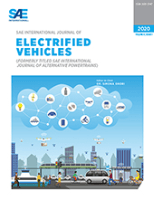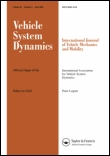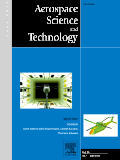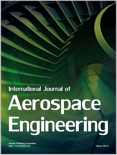
Journal of Unmanned Vehicle Systems
Scope & Guideline
Unleashing potential through cutting-edge research in autonomous systems.
Introduction
Aims and Scopes
- Autonomy Assessment:
Research dedicated to quantifying and assessing the level of autonomy in unmanned systems, including frameworks and methodologies to evaluate performance. - Applications in Disaster Management:
Exploration of the use of unmanned aerial systems (UAS) in disaster risk reduction and management, particularly in environmental monitoring and response efforts. - Advanced Control Systems:
Development of sophisticated control algorithms such as deep reinforcement learning for enhancing the operation and stability of unmanned vehicles. - Sensor Integration and Data Analysis:
Innovative approaches for integrating various sensors with unmanned vehicles to collect, analyze, and interpret data for diverse applications. - Environmental Monitoring:
Utilization of unmanned systems for environmental assessment, including water quality monitoring and wildlife surveys, demonstrating their utility in ecological research. - Engineering and Design Innovations:
Focus on the design and engineering of new unmanned vehicle systems, including amphibious drones and hydrofoil boats, to expand operational capabilities.
Trending and Emerging
- Deep Learning in UAV Operations:
The application of deep learning techniques, particularly in motion control and data analysis, is increasingly prominent, showcasing the integration of AI in unmanned systems. - Environmental and Ecological Applications:
The use of unmanned vehicles for environmental monitoring and wildlife studies is on the rise, reflecting a growing interest in sustainability and ecological research. - Innovative Sensor Technologies:
The integration of advanced sensors for data collection and analysis, such as aerial imagery and sound localization, is gaining importance, enhancing the capabilities of unmanned systems. - Complex System Design:
Research focusing on the design of complex unmanned systems, such as amphibious vehicles and hydrofoils, indicates a trend towards multifunctional and versatile platforms. - Real-World Application Case Studies:
An increase in publications that present case studies on the real-world application of UAV technologies in various fields indicates a shift towards practical implementations and operational testing.
Declining or Waning
- Human Factors in UAV Operations:
Research on human factors related to unmanned systems, which has seen a decrease in focus, possibly due to the increasing automation and autonomy of these systems. - Basic UAV Applications:
Earlier publications often emphasized basic UAV applications without a strong technological or methodological innovation; this focus has waned as the field matures. - Non-technical UAV Studies:
Studies that do not incorporate technical advancements or novel methodologies in unmanned systems are becoming less frequent, indicating a shift towards more applied and technical research.
Similar Journals

EURO Journal on Transportation and Logistics
Unlocking the future of transportation through collaboration.The EURO Journal on Transportation and Logistics, published by ELSEVIER, is a premier open access journal dedicated to advancing the fields of transportation and logistics. Since its establishment in 2013, the journal has become a vital platform for disseminating cutting-edge research and insights, reflecting its significant impact in the academic community, as evidenced by its Q1 ranking in both Management Science and Operations Research and Modeling and Simulation as of 2023. Hailing from the Netherlands, this journal caters to a diverse array of scholarly disciplines, as highlighted by its ranking within the top quartiles across various Scopus categories including Mathematics, Decision Sciences, and Social Sciences. With a commitment to transparency and accessibility through its open access policy since 2020, the journal strives to engage not only researchers but also professionals and students, fostering a collaborative environment for the exploration of innovative solutions within the transportation and logistics sectors.

Journal of the Korean Society for Aeronautical and Space Sciences
Fostering Excellence in Aerospace ScholarshipThe Journal of the Korean Society for Aeronautical and Space Sciences is a dedicated platform for the dissemination of cutting-edge research in the fields of aerospace engineering and space sciences. Published by the esteemed Korean Society for Aeronautical & Space Sciences, this journal aims to bring together innovative findings and technological advancements from around the globe, thereby contributing to the ongoing development of the aerospace sector. Operating from South Korea, the journal holds an ISSN of 1225-1348 and an E-ISSN of 2287-6871, catering to both print and digital scholarly communication. Although categorized in Q4 within the Aerospace Engineering segment and ranked 139 out of 153 on Scopus, the journal plays a crucial role in fostering research collaboration and knowledge exchange among professionals, researchers, and students alike. With converged years from 2019 to 2024, it continuously seeks to enhance its contributions to the academic community through rigorous peer review and publication of original research. Given the evolution of aerospace technologies, this journal is vital for anyone involved in aeronautical research, ensuring that their work reaches the right audience.

ROBOTICS AND AUTONOMOUS SYSTEMS
Exploring Innovations in Robotics and Autonomy.ROBOTICS AND AUTONOMOUS SYSTEMS, published by Elsevier, is a leading journal in the fields of robotics and automation, providing a platform for the dissemination of high-quality, peer-reviewed research. With an impressive impact factor and a prestigious reputation, this journal is classified in the Q1 category for major fields including Computer Science Applications, Control and Systems Engineering, Mathematics, and Software as of 2023. The journal boasts an extensive archive dating back to 1988, reflecting the evolution of the discipline and fostering innovative research discussions that are crucial for advancements in autonomous technologies. Researchers, professionals, and students are encouraged to contribute to and benefit from the ongoing dialogue within these dynamic fields. Accessible through various academic resources, ROBOTICS AND AUTONOMOUS SYSTEMS stands as a pivotal information source for those dedicated to exploring the frontiers of intelligent systems.

Journal of Aerospace Information Systems
Connecting Disciplines, Elevating Aerospace KnowledgeJournal of Aerospace Information Systems, published by the American Institute of Aeronautics and Astronautics, is a premier scholarly platform dedicated to advancing the interdisciplinary field of aerospace information systems. With a focus on innovative research and practical applications, this journal supports the dynamic integration of aerospace engineering, computer science, and electrical engineering. Positioned in Q2 quartiles for 2023 in its respective categories, it ranks notably in Aerospace Engineering (#52/153) and Electrical and Electronic Engineering (#357/797), indicating its significant influence within the scientific community. Research published within its pages addresses a diverse range of technological advancements and applications that are vital for the development of contemporary aerospace systems. As an open-access journal, it facilitates broader dissemination of knowledge, allowing researchers, professionals, and students to engage with cutting-edge discoveries and methodologies. With its competitive impact and commitment to fostering innovation, the Journal of Aerospace Information Systems is an essential resource for anyone involved in the burgeoning field of aerospace technology.

SAE International Journal of Commercial Vehicles
Exploring the Future of Commercial Vehicle TechnologySAE International Journal of Commercial Vehicles, published by SAE International, stands at the forefront of automotive engineering research, fostering innovation and development in the commercial vehicle sector. With an ISSN of 1946-391X and an E-ISSN of 1946-3928, the journal plays a critical role in disseminating high-quality research, theoretical advancements, and practical applications across various facets of commercial vehicles. As part of the notable SAE publication portfolio, it enjoys a respectable 2023 Q3 ranking within the automotive engineering category and holds a significant position at Rank #72/125 in Scopus, reflecting its growing impact and relevance. The journal's themes encompass innovative technologies, safety advancements, and regulatory developments, providing researchers and industry professionals with vital insights essential for tackling contemporary challenges. Though currently not an open-access publication, its contribution to the engineering community is invaluable, paving the way for future studies and collaborative efforts in the automotive field.

SAE International Journal of Electrified Vehicles
Pioneering Research for Sustainable Vehicle SolutionsSAE International Journal of Electrified Vehicles, published by SAE International, is a pioneering journal dedicated to the field of electrified transportation. Operating since 2020, this journal offers a crucial platform for researchers, engineers, and practitioners who are at the forefront of advancements in vehicle electrification and related technologies. With an ISSN of 2691-3747 and an E-ISSN of 2691-3755, it is indexed within respected databases, showcasing its commitment to high-quality research in Automotive Engineering and Fuel Technology. As part of the Q3 category in the 2023 rankings for both automotive and energy sectors, the journal facilitates the exchange of innovative ideas and groundbreaking studies that contribute to the evolution of the electrified vehicle industry. While currently not open access, the journal offers various subscription options for readers, making valuable insights accessible to a broad audience. Conducting research in this dynamic field, the SAE International Journal of Electrified Vehicles is vital for professionals striving to push the boundaries of technology and sustainability in modern transportation.

VEHICLE SYSTEM DYNAMICS
Exploring the future of safe and efficient vehicle design.VEHICLE SYSTEM DYNAMICS, published by Taylor & Francis Ltd, is a premier journal dedicated to advancing the field of automotive and mechanical engineering. With an impressive impact factor and categorized in the top quartiles (Q1) of Automotive Engineering, Mechanical Engineering, and Safety, Risk, Reliability, and Quality, this journal has established itself as a vital resource for researchers, industry professionals, and academics alike. Spanning from 1972 to 2024, VEHICLE SYSTEM DYNAMICS focuses on disseminating high-quality, peer-reviewed research that addresses critical challenges and innovations in vehicle dynamics and system performances. The journal is based in the United Kingdom and continues to contribute significantly to the global discourse on safe and efficient vehicle design and operation. Readers can access the journal's content through various platforms, ensuring the latest research is readily available to inform and inspire future advancements in the field.

International Journal of Aeronautical and Space Sciences
Advancing the Frontiers of Aerospace ResearchThe International Journal of Aeronautical and Space Sciences, published by Springer, is a prominent platform dedicated to advancing research and innovation in the fields of Aerospace Engineering, Control and Systems Engineering, Electrical and Electronic Engineering, and Materials Science. With an ISSN of 2093-274X and an E-ISSN of 2093-2480, the journal has established itself as a vital resource since its inception in 2011, currently offering insights that span a wide range of contemporary challenges and technological advancements in aeronautics and space exploration. Ranking in the Q2 category across multiple disciplines, including Aerospace and Control Engineering, signifies its recognized impact and quality within the academic community. Although not an open-access journal, it remains accessible to researchers, professionals, and students seeking to enhance their understanding of complex aerospace systems and their applications. The journal’s commitment to publishing high-quality research makes it indispensable for those aiming to contribute to, or stay informed about, the evolving landscape of aerospace technology.

Aerospace Science and Technology
Connecting Scholars, Advancing Aerospace KnowledgeAerospace Science and Technology, published by ELSEVIER FRANCE-EDITIONS SCIENTIFIQUES MEDICALES ELSEVIER, is a leading journal in the field of aerospace engineering, boasting an impressive 2023 Q1 ranking and a significant position in the Scopus Ranks, where it stands at Rank #7 out of 153 in the Engineering - Aerospace Engineering category, reflecting its credibility and impact with a 95th percentile ranking. Since its inception in 1997, this journal has provided a robust platform for the dissemination of pioneering research and advancements in aerospace technology, focusing on innovative methodologies and applications in the aerospace sector. With a commitment to open access, researchers, professionals, and students can easily engage with cutting-edge findings that drive the industry forward. The journal not only seeks to expand knowledge but also aims to foster collaboration among scholars across the globe, making it an essential resource for anyone looking to stay at the forefront of aerospace innovation. For more information, visit its website or refer to its dedicated address at 65 Rue Camille Desmoulins, CS50083, 92442 Issy-Les-Moulineaux, France.

International Journal of Aerospace Engineering
Fostering Insight and Innovation in Aerospace EngineeringThe International Journal of Aerospace Engineering, published by HINDAWI LTD, stands at the forefront of innovation and research in the field of aerospace engineering. With an impact factor reflecting its contributions to the discipline and classified in Quartile 3 (Q3) for the year 2023, this journal provides a platform for high-quality, peer-reviewed articles that delve into advancements and challenges in aerospace technology and applications. Since its inception in 2008, the journal has embraced an Open Access model, promoting unrestricted dissemination of research findings to foster collaboration and knowledge sharing among researchers, professionals, and academia. The journal covers a broad spectrum of topics, aiming to enhance understanding and give insight into aerospace engineering's multifaceted aspects. With its coverage in the Scopus database, ranking 71 out of 153 in the aerospace engineering category, the journal is a valuable resource for those engaged in this dynamic field, ensuring that high-impact research receives the visibility it deserves.